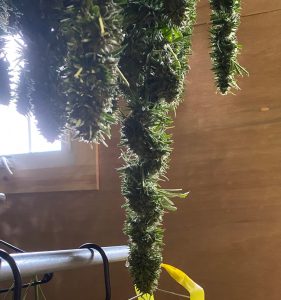Once again, it’s that time of the season when we celebrate the great abundance of hemp harvest. It’s been an exceptional year for the hemp, showing amazing resilience in the face of frequent and often heavy rain. Now we are benefiting from the fruits…flowers??…of our labor, though, if we’re being honest, the plants do most of the work.

Samples off to the lab
Even so, there’s plenty to keep us busy once these sticky, fragrant buds are ready to be harvested.
The first step in our harvest process is not a glamorous one, but it satisfies compliance requirements put forth by the State of Vermont. We ship samples from each of our varieties off to an independent lab, where they perform an analysis of cannabinoid content. This ensures that we are indeed growing hemp that’s rich in CBD and not marijuana high in THC. While the hemp does have some visible qualities that distinguish it from marijuana, it would be easy to confuse the two. The lab results also provide an early indication as to what varieties are the best performers, as well as an indication of which plants should be harvested first. In the growing cycle of hemp, THC is produced later in their lives, making it important to first harvest the plants that are starting to exhibit a higher level of THC production.

Andy examines a bud after trimming
It’s usually the case that the ones that appear ready for harvest through our own observations are confirmed as such by the lab results. Once we’ve identified the first strain to harvest, away we go! We typically employ some seasonal help during this process (thanks Brandon, Betsy, and Erin!) so that Ben and I can stay on the trimmer machines while bins of hemp are shuttled up to us. The trimmer machines have a table top that looks like a fan, with slats in it that allow the fan leaves to penetrate down to very sharp rotating blades. This removes a lot of extraneous vegetative matter while preserving the integrity of the flower buds, which are too large to enter the gaps. It’s a good deal of extra work at this point in the harvest, but it results in a quicker and more thorough dry and also provides a chance to inspect the buds and remove any that are compromised. The leaf litter is collected below the trimmer and returned to the field to compost back into soil.

The CBDV buds have a spiral quality
Once we have a bin full of bucked and trimmed buds, we load them into my truck and take the quick ride up to the Bravo Barn, where this year we have a new fully-insulated, climate-controlled room (thanks Travis & team!) ready for the plants. From the bins, the branches transfer quickly to hangers, thanks to the harvesters who do so in such a way as to leave a natural hook intact by cutting the stalk at certain locations. We load up clothes hangers densely with buds and hang them on metal rods attached to the ceiling in multiple levels, essentially creating a curtain of hemp flowers. When the outside air is dry, we’ll leave the windows and doors open with fans on, and when the air is damp or cold, we close it up and run the dehumidifiers.

A curtain of high-CBD hemp
We’ve found that drying is a critical part of the process and we’ve evolved from hanging whole plants in the barn to singular branches. As previously noted, it’s more work up front, but it really streamlines the rest of the process and also creates an impressive room, packed wall-to-wall with cannabis, emanating a floral aroma that is truly exhilarating. In this carefully monitored environment, the plants rapidly lose a lot of their water weight and become dry to the touch. After a couple weeks in our drying room, we shuck the buds off the stems by pulling the dried branches through holes drilled in wood, allowing them to drop into food-grade plastic bags, ready for the storage room until the time comes to extract the oil from them.
So, the harvest is in on another year of growing hemp at Bravo Botanicals. I’m hesitant to say that this the “reward” of our work, for every step of the process from seed to shelf is informative and enjoyable in its own way. We’re grateful to be a part of it in our own small way.
– Andy Loughney




